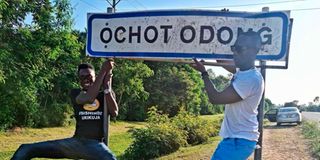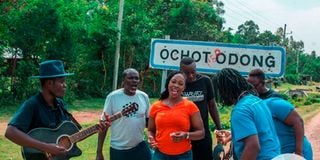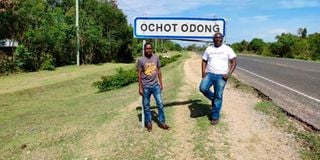Is this the most photographed, famous signpost on our roads?

Boaz Hosea and Bray Okut pose for a picture at the famous Ochot Odong’ road signage in Kendu Bay, Homa Bay County.
What you need to know:
So much has the post got a fanatical following that Kenyans created a fan page on Facebook.
The fan page, a virtual noticeboard, presents some of the naughtiest of poses at the site.
For close to an hour, we watched as vehicles stopped, the occupants alighted, posed for pictures at a road sign with the writings, “Ochot Odong” in Homa Bay and then drove off.
The signpost is arguably one of Kenya’s most photographed signage as it continues to attract tens of road users, who having seen similar pictures posted on social media, are glad to have an image of their own.
It is even more curious that the local tourists attracted to the road sign choose to bypass the scenic Lake Simbi Nyaima a few kilometres away.
So, what could be the story behind a simple road sign, which makes it stand out along the 70km Katito-Homa Bay Road?
In Dholuo, depending on the intonation, the words on the sign post can have two meanings.
First, they mean, “a prostitute has been left behind” and second, “something has broken loose and remained behind”.
A legend is told of how a man accompanied by his mistress attended the then famous Kendu Bay Agricultural Society of Kenya Show.
Kendu Show, as it was fondly known, was an entertainment hub, what overshadowed the agricultural activities. Revellers came from far and wide to dance to music played by various bands from all over Kenya.

Calvin Ouma (second left) of Calvins Tours and Travels leads local tourists in song and dance at the famous Ochot Odong’ sign post in Kendu Bay, Homa Bay County.
Mr Felix Odhiambo, 42, a resident of Karabondi where the road sign stands, recounts that the mistress disappeared in the crowds.
“There being no mobile phones then, the gentleman went on a search, ending up in our village, asking anyone he met if they had spotted his mistress,” says Mr Odhiambo.
The man soon became a figure of ridicule as residents said with glee, “Ochot Odong”— meaning the mistress had remained behind.
Another story told is that in the past, a journey to the lakeside town of Homa Bay was a bumpy one due to poor roads. Like many tales that were never authenticated, it has been narrated that the particular section where the sign stands had a very big pothole.
With very few minibuses plying the route, travellers would load as much as they could on the carrier.
The big potholes caused trouble as luggage would fall off and passengers, keen not to leave their belongings behind, would persistently shout, “Ochot Odong! Ochot Odong!” to get the attention of the driver to stop, leading to the name.
Many of those who stop by, take photos and post on social media, however, assign the first meaning – that the mistress has been left behind – to the two words.
“I was attracted to it, because of the two Dholuo words that mean a sex worker has been left behind,” says 28-year-old, Vincent Mc’Gilloh, an agribusiness manager.
Fan page on Facebook
So much has the post got a fanatical following that Kenyans created a fan page on Facebook – The Most Famous Sign Post, Ochot Odong.
The fan page, a virtual noticeboard, presents some of the naughtiest of poses at the site.
Wamwara Orinda, 85, whose home lies 100 metres from the road sign, however, dismisses stories told about Ochot Odong as lies.
“The pothole story is not true, that part of the road was firm and had sand with no deep pothole,” he says.
Mr Orinda, a retired school teacher with 32 years experience, says the spot where the road sign stands was previously a shopping centre that served the larger Karabondi region. Adding that the shops were located on both sides of the road before it was tarmacked.
The tarmacking of the road meant its expansion, which ate into the upper part of the shopping centre with kiosks on one side moved.
“Until then, the shops had been divided such that one end belonged to the Kapiyo clan and the other Kagana,” recalls Mr Orinda.
The shopping area, however, stood on the Kapiyo clan’s land that had been offered to the Koganas.

Bruce Media CEO Otis Konsega (right) with a friend pose for a picture at the famous Ochot Odong’ road signage in Kendu Bay, Homa Bay County.
“Locals built their kiosks next to each other in a manner they would congregate to offer a sense of security to deter burglary that was common for isolated kiosks,” he says.
The senior citizen narrates that the expansion forced the Koganas to relocate back to their land in Kanyangwena- some few kilometres away.
The Israeli contractor constructing the road whom locals had nicknamed Yuda (in reference to his Jewish heritage), perturbed by the constant term “Ochot Odong’ would be heard asking what the name meant.
And as Orinda recounted, the locals described it in Kiswahili as, “Duka zimekatika lakini zingine zimebaki.”
That meant the shops have been “cut” (Ochot) and the others remained (Odong’) hence the name of the spot Ochot Odong’.
Despite the frequent visitors, the centre lies in a desolate state far much from its famous social media status.
The only notable institution being the nearby Karabondi Bidii Mixed Secondary School.
The shopping centre has since been turned into rented residential spaces.





